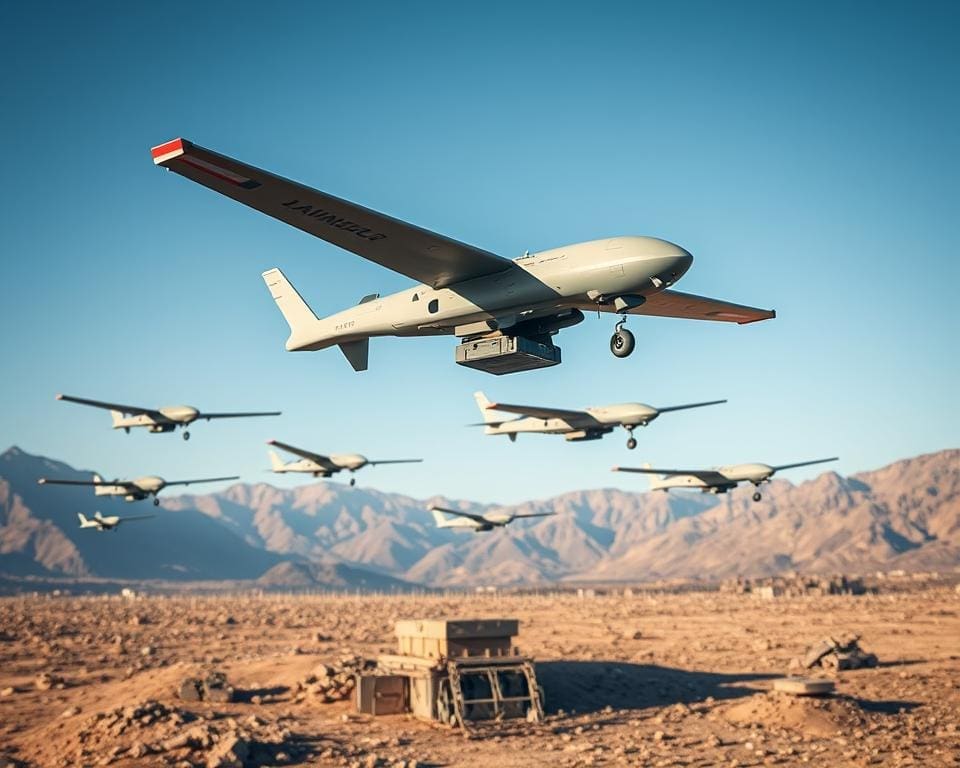The evolution of cargo drones for military logistics marks a significant milestone in enhancing operational efficacy. As military organisations continuously seek innovative solutions, the adoption of unmanned aerial vehicles (UAVs) is becoming increasingly instrumental in streamlining supply chains. These military logistics drones provide real-time responses essential for rapid deployment, tactical support in remote terrains, and disaster relief initiatives.
Early adopters, including the US Army and the UK Ministry of Defence, are harnessing these advancements to optimise logistics, effectively reducing lead times in mission-critical scenarios. The transformative potential of cargo drones for military logistics is not only revolutionary but also a testament to a new age of operational excellence.
The Rise of Cargo Drones in Military Logistics
The utilisation of cargo drones for military logistics has experienced a significant surge, reflecting a broader recognition of their strategic advantages by various nations. These drones have become invaluable tools in addressing the logistical challenges faced by armed forces, particularly in remote regions where traditional transport options are limited. With enhancements in military drone technology, these aerial vehicles now boast longer flight ranges and improved payload capacities, making them well-suited for operations that demand efficiency and reliability.
Noteworthy initiatives, such as the UK’s ‘Project Orbiter’, exemplify the commitment to advancing drone delivery for armed forces. These projects demonstrate the practical applications of cargo drones in real-world combat scenarios, successfully merging with existing logistical frameworks. As military operations continue to evolve, the role of cargo drones becomes increasingly vital, enabling rapid and effective delivery of essential supplies and equipment.

The integration of cargo drones not only bolsters military capabilities but also enhances situational awareness and operational effectiveness. Their innovative navigation systems facilitate accurate deliveries, even in challenging environments. As nations embrace these technological advancements, the rise of cargo drones in military logistics signifies a transformative shift in how armed forces approach supply chain management.
Understanding Military Drone Technology
The evolution of military drone technology represents a significant leap in operational capabilities within logistics. Unmanned aerial vehicles for logistics have transformed traditional supply chains, offering a level of efficiency in action previously unimaginable. At the core of these advanced systems lies a sophisticated interplay of autonomous navigation, payload management, and robust communication technologies.
Autonomous navigation enables these drones to traverse challenging landscapes with precision. GPS and sensor integration ensure they can avoid obstacles and maintain a reliable course, even in hostile environments. Such features are essential for successful military operations where reliability is paramount.
Furthermore, drones are equipped to manage various payloads, ranging from medical supplies to munitions, ensuring that the right materials reach the right place at the right time. Effective payload management systems allow for swift adjustments, accommodating the diverse needs of military missions.
Communication systems empower unmanned aerial vehicles for logistics to relay real-time data back to command centres. This connectivity aids in strategic planning and situational awareness, forming a critical component of military operations. Understanding these technological foundations highlights how efficiency in action translates directly to logistical success.
Key manufacturers such as Northrop Grumman and General Atomics are driving innovation in this field. Their commitment to developing cutting-edge drone solutions enhances military preparedness and effectiveness, ensuring these technological marvels are ready to respond to the complexities of modern warfare.
Benefits of Using Aerial Delivery Drones
The integration of aerial delivery drones into military logistics presents numerous advantages that significantly enhance operational capabilities. These advantages not only streamline logistics but also contribute to more effective and timely responses in various scenarios.
Rapid Deployment Capabilities
Aerial delivery drones exhibit remarkable rapid deployment capabilities. They enable swift transportation of goods directly to troops in challenging terrains or areas where traditional infrastructure may be compromised. This agility perfectly aligns with the military’s urgent need to maintain effective supply chains. The ability of drones to deliver critical supplies within hours, or even minutes, exemplifies one of the most compelling benefits of aerial delivery drones.
Cost Efficiency in Supply Chains
Cost efficiency represents another crucial benefit associated with the adoption of aerial delivery drones. By reducing labour costs through automation, these drones provide more predictable delivery schedules. Moreover, their lower fuel consumption compared with conventional logistics methods further enhances overall operational efficiency. The shift towards logistics automation with drones not only saves money but also optimises resource allocation, paving the way for more efficient military logistics solutions.
Challenges Faced by Military Logistics Drones
The integration of drones into military logistics is not without its hurdles. As advancements in drone technology continue, various challenges faced by military logistics drones must be addressed for effective deployment in operational settings.
Regulatory Considerations
One of the primary obstacles lies in regulatory considerations. The strict regulations governing airspace can significantly impact the operational effectiveness of drones. Limitations regarding altitude and designated flight paths, particularly over populated areas, complicate military operations. Collaborating with civil aviation authorities presents yet another complexity. As the number of drone deployments increases, establishing clear guidelines and protocols becomes essential for safe and effective utilisation.
Technical Limitations
The technical limitations associated with military logistics drones are equally significant. Issues like battery life restrict the duration and range of drone missions, impacting logistical efficiency. Payload limitations hinder the capacity of these drones to deliver larger supplies. In addition, advanced measures are necessary to combat the growing threat of cyber attacks, requiring innovative solutions to ensure the security of drone operations. Meeting these challenges head-on is critical for the future success of military logistics.
Cargo Drones for Military Logistics: Efficiency in Action
Cargo drones are transforming the landscape of military logistics, introducing remarkable efficiency in action. These unmanned aerial vehicles for logistics have demonstrated their potential not only in combat zones but also in humanitarian missions across various terrains. Real-world applications illustrate their ability to deliver supplies rapidly, overcoming geographic obstacles that traditionally hinder conventional transport methods.
In Afghanistan and Iraq, the deployment of cargo drones showcased their decisive impact on mission success. Units stationed in remote areas experienced unprecedented reductions in delivery times, allowing them to access essential supplies that were previously challenging to transport. This agility in logistics fosters enhanced operational readiness, essential for adapting to evolving military demands.
Unmanned aerial vehicles for logistics also significantly reduce operational costs through streamlined processes. Traditional supply chain methods often involve complex logistics that can delay support to troops in critical moments. The use of cargo drones simplifies these complexities, providing direct routes and minimising the resources needed for transportation.
As military operations evolve, integrating cargo drones into the logistics framework becomes vital. Their capacity to deliver aid efficiently, even in adverse conditions, positions them as indispensable assets. The future of military logistics lies in embracing this innovative technology, which not only enhances effectiveness but also embodies the spirit of adaptability and resilience.
The Future of Logistics Automation with Drones
The landscape of military logistics is on the brink of transformation, driven by remarkable advancements in drone technology. As organisations seek to enhance their operational efficiency, logistics automation with drones emerges as a pivotal solution. The evolution of the future of cargo drones promises not only to streamline supplies but also to revolutionise the speed and reliability of military operations.
Innovations on the Horizon
Cutting-edge developments lie ahead in the realm of cargo drones. AI-driven logistics systems and breakthroughs in battery technology are setting the stage for a new generation of aerial delivery solutions. These innovations are anticipated to endow military logistics with enhanced capability, such as improved flight endurance and autonomous operational frameworks. Collaborations with tech titans, for instance, Amazon and Google, herald a wave of _innovative solutions for military logistics_ that can optimise delivery and tracking systems in complex scenarios.
Integrating Drones into Existing Supply Chains
For military organisations, integrating drones into established supply chains will prove essential in cultivating an agile logistics framework. Tailoring current systems to accommodate drone operations will enhance responsiveness and adaptability in dynamic environments. As a result, military entities will witness increased improvements in logistical capabilities, solidifying their ranks through effective deployment and distribution. The integration of drones is not merely an upgrade but a crucial step toward a resilient logistics ecosystem.
Tactical Aerial Delivery: Real-World Applications
The integration of drones into military logistics represents a monumental shift in how operations are conducted, particularly through tactical aerial delivery. Real-world applications of drones, such as supplying frontline troops with critical medical supplies, illustrate the remarkable adaptability and responsiveness these machines offer in dynamic environments. Drones have become indispensable in ensuring that vital resources reach their destination swiftly, enhancing overall operational efficiency.
One notable instance involves the use of a well-known drone manufacturer’s technology to deliver urgent medical provisions to isolated units during training exercises. Such operations not only underscore the effectiveness of tactical aerial delivery but also highlight the potential for expanding military logistics solutions that can save lives in high-stakes situations. In addition, these successful deployments showcase the tactical advantages provided by drone technology, allowing forces to respond to changing circumstances with unparalleled speed.
The lessons learned from these pioneering projects pave the way for future innovations in drone utilisation within the military sector. By examining the strengths and challenges of these real-world applications, defence organisations can refine their approach to integrating drones into existing supply chains. Increased investment and focussed research into military logistics solutions promise a future where aerial delivery systems become a mainstream method of operational support, enhancing not just efficiency but also mission success in the field.









